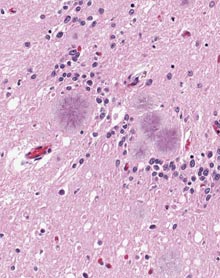Finding Early Signs of Mad-Cow Disease
Researchers have made a list of blood proteins that act as early indicators of a group of diseases including bovine spongiform encephalopathy (BSE), also known as mad-cow disease. Their results could lead to commercial early warning tests for the disease in farm animals. The methods used for the study–one of the most comprehensive analyses of the gene expression characteristic of a disease–are now being applied to other diseases and could lead to early diagnosis tests for other neurological diseases such as Alzheimer’s.

The human form of BSE, a fatal degenerative neurological disorder called Creutzfeldt-Jakob disease, can be contracted by eating meat contaminated with infectious agents called prions. Prions are proteins that cause other proteins to misfold, particularly in the brain and other neural tissue. In the first stages of the disease, prions replicate and accumulate in the brain. This is followed by abnormal activation of supportive cells, the degeneration of neural connections, and finally brain-cell death. By the time the disease can be diagnosed, these processes are already well under way.
In order to illuminate these ordinarily invisible processes, the researchers infected mice with prions and followed changes in the expression of every single gene in their brains at 10 points throughout the course of the disease. This global approach generated about 30 million data points. In order to separate signal from noise–that is, to find genes that were truly a significant part of the disease process–the researchers developed new statistical methods for looking at how the genes interact with one another in interrelated groups. Of an initialgroup of 7,400 implicated genes, they winnowed the number down to about 300 that are “at the heart of prion response,” says Leroy Hood, president and co-founder of the Institute for Systems Biology in Seattle, WA. Hood has pioneered this type of analysis, which he calls systems biology, over the past decade and led the new research with George Carlson, director of the McLaughlin Research Institute in Great Falls, MT.
The researchers further studied the 300 genes to find those that are known to code for proteins that are secreted into the blood. They discovered that some of those proteins could be found in the blood of infected mice 8 to 10 weeks before they started showing any symptoms. These results are described today in the journal Molecular Systems Biology. Hood says that the researchers are now looking into developing commercial tests for the human and bovine forms of prion disease, based on the blood biomarkers they have uncovered. Cows and humans have almost identical blood proteins to those uncovered in the mouse study.
“This global analysis let us pick up lots of features that were previously unknown,” says Hood. Only 200 of the implicated genes have a role in the disease process that is understood. So further study of the remaining 100 could lead to new insights into how prions cause disease. And all of the genes provide therapeutic targets for drug developers to investigate.
Hood now hopes to develop blood tests for other difficult-to-diagnose brain diseases. Having proven their analytical method in prion diseases, Hood says the group will apply it to mouse models of other degenerative diseases of the nervous system including Alzheimer’s and Huntington’s. Like Creutzfeldt-Jakob, “these diseases are difficult to diagnose in their early stages,” says Hood. The earlier the diagnosis, the better the outcomes are likely to be.
Keep Reading
Most Popular
Large language models can do jaw-dropping things. But nobody knows exactly why.
And that's a problem. Figuring it out is one of the biggest scientific puzzles of our time and a crucial step towards controlling more powerful future models.
The problem with plug-in hybrids? Their drivers.
Plug-in hybrids are often sold as a transition to EVs, but new data from Europe shows we’re still underestimating the emissions they produce.
Google DeepMind’s new generative model makes Super Mario–like games from scratch
Genie learns how to control games by watching hours and hours of video. It could help train next-gen robots too.
How scientists traced a mysterious covid case back to six toilets
When wastewater surveillance turns into a hunt for a single infected individual, the ethics get tricky.
Stay connected
Get the latest updates from
MIT Technology Review
Discover special offers, top stories, upcoming events, and more.